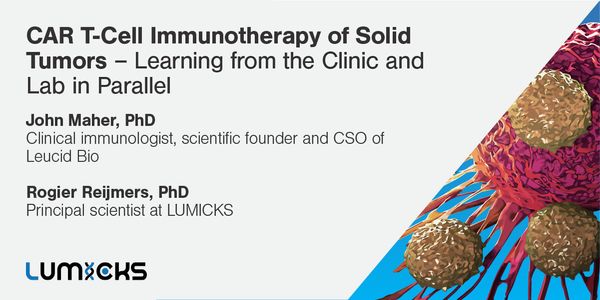Engineering T cells
Engineering T cells is a broad description of techniques used to modify a T cells obtained from a patient or healthy donor. T cells are a subset of immune cells responsible for targeting and killing tumor cells. Once harvested from a patient or donor, the T cells can be engineered in a laboratory making them better capable of killing a specific tumor. Examples of adoptive cell therapies using engineered T cells are T cell receptor (TCR)-engineered T cells and chimeric antigen receptor (CAR) T cells.
-
SEP 23, 2020 | 3:00 PMFor more than a century, breakthroughs in biological sciences have relied on the ability to study cells outside of respective organisms. While majority of cell culturing is still performed u...Speaker: Jun Park, PhDSEP 23, 2020 | 1:30 PMExtracellular vesicles (EVs) are lipid bilayer-delimited pieces of cells that are released from the plasma membrane as "ectosomes" and from the endosomal system as "exosomes.&...SEP 23, 2020 | 12:00 PMExtracellular ligands bind to receptors on the cell surface leading to receptor internalization. Once internalized into small vesicles, the vesicles fuse with an organelle known as the sorti...SEP 23, 2020 | 12:00 PMB cells and tertiary lymphoid structures (TLS) promote immunotherapy response 1:00–1:30 pm PDT Presented By: Rafet Basar, MD...Speaker: Handan Xiang, PhD , Pei-Yu Chen, PhD , Hiranmayi Ravichandran, MS , Rafet Basar, MD , Amir Horowitz, PhDPresented at: 9th Annual Fluidigm Mass Cytometry Virtual Summit
SEP 23, 2020 | 10:30 AMIntestinal organoids are self-organizing, 3D structures derived from either pluripotent stem cells or from primary tissues with the abiltiy to recapitulate some of the spatial architecture a...Speaker: Kevin SuSEP 23, 2020 | 9:00 AMExtracellular vesicles (EVs) are nanosized vesicles containing active proteins, lipids, and different types of genetic material such as non coding RNA species, related to the characteristics...SEP 23, 2020 | 8:00 AMDate: Time: Over the last couple of years, it has become apparent that affinity-tuned CAR T cells display enhanced expansion and prolonged persistence in patients and that this strategy can...SEP 23, 2020 | 7:30 AMCell culture continues to be a critical tool for most life science research and applications. From HeLa to iPSCs and 3D to organoids, culture methods have become more advanced and techniques...Speaker: Marina Wiklander, PhDSEP 23, 2020 | 6:00 AMMicroRNAs (miRs) are small non-coding RNAs whose expression is altered in several types of human cancers. Recent evidence supports their inter-cellular transfer through extracellular vesicle...SEP 23, 2020 | 12:00 AMLearning Objectives: 1. Understand methods of isolating and enriching exosomes along with their pros/cons of the different techniques 2. What do we mean when we talk about subtyping, and wha...SEP 23, 2020 | 12:00 AMI will present our new computer vision algorithm, ST-Net, which can computationally synthesize spatially resolved transcriptomics directly from H&E histology images (He et al. Nature Bio...SEP 23, 2020 | 12:00 AMGeoMx Digital Spatial Profiling Technology! The GeoMx Digital Spatial Profiler (DSP) is a novel platform developed by NanoString. This leading digital technology offers multiplexed measureme...SEP 23, 2020 | 12:00 AMThe extracellular matrix (ECM) is a three-dimensional structure that provides physical support for tissues/organs and biochemical/biomechanical cues for tissue morphogenesis, differentiation...SEP 23, 2020 | 12:00 AMExtracellular vesicles (EV) from many cell types have demonstrated therapeutic potential against many different diseases. Inhibiting progress in this area is the capability to produce EVs in...SEP 23, 2020 | 12:00 AMChronic kidney disease (CKD) is a major public health threat, affecting 11-15% of the U.S. population alone. Currently, there are no effective therapies to cure CKD. Drug therapies are not p...SEP 23, 2020 | 12:00 AMReactive oxygen species (ROS) are well-known for their detrimental effects leading to oxidative stress, cell death, aging, and degenerative disorders. However, there is increasing evidence t...SEP 23, 2020 | 12:00 AMChronic kidney disease (CKD) is a global health threat, affecting over 10% of the world population, including an estimated 37 million Americans. Importantly, glomerular diseases account for...SEP 17, 2020 | 4:30 PMT cells are the adaptive immune system’s first responders to any virus, circulating in the blood to detect and quickly multiply to attack the virus, and also support the development of...Speaker: Sean Nolan , Patrick Raber, PhD , Thomas Snyder, PhDSEP 17, 2020 | 12:00 PMTherapeutic antibody can provide key protection or lifesaving treatment for those who haven't been or can’t be vaccinated, or when vaccines don’t “take". We galvan...SEP 17, 2020 | 1:30 PMThe Allen Institute for Cell Science is generating a state space of stem cell signatures. The goal is to understand cell organization, identify cell states, and elucidate how cells transitio...SEP 17, 2020 | 12:45 PMImmunotherapy such as immune checkpoint inhibitor antibodies have revolutionized the treatments for hard-to-treat cancers, with durable responses observed in clinics. However, the overall re...AUG 06, 2020 | 10:00 AMCurrent cancer management follows a multipronged approach that include surgery, radiation, and chemotherapy. There is a pressing need for a platform technology to provide precision chemother...AUG 06, 2020 | 12:00 AMCurrent cancer management follows a multipronged approach that include surgery, radiation, and chemotherapy. There is a pressing need for a platform technology to provide precision chemother...AUG 04, 2020 | 8:00 AMDATE: June 23, 2020 TIME: 6:00 am PDT, 9:00 am EDT In this webinar for scientists and researchers, Rama Shivakumar, a senior scientist at MaxCyte Inc., will highlight powerful case studies t...
SEP 23, 2020 | 3:00 PM
For more than a century, breakthroughs in biological sciences have relied on the ability to study cells outside of respective organisms. While majority of cell culturing is still performed u...
Speaker:
Jun Park, PhD
SEP 23, 2020 | 1:30 PM
Extracellular vesicles (EVs) are lipid bilayer-delimited pieces of cells that are released from the plasma membrane as "ectosomes" and from the endosomal system as "exosomes.&...
SEP 23, 2020 | 12:00 PM
Extracellular ligands bind to receptors on the cell surface leading to receptor internalization. Once internalized into small vesicles, the vesicles fuse with an organelle known as the sorti...
SEP 23, 2020 | 12:00 PM
B cells and tertiary lymphoid structures (TLS) promote immunotherapy response 1:00–1:30 pm PDT Presented By: Rafet Basar, MD...
Speaker:
Handan Xiang, PhD
, Pei-Yu Chen, PhD
, Hiranmayi Ravichandran, MS
, Rafet Basar, MD
, Amir Horowitz, PhD
Presented at: 9th Annual Fluidigm Mass Cytometry Virtual Summit
SEP 23, 2020 | 10:30 AM
Intestinal organoids are self-organizing, 3D structures derived from either pluripotent stem cells or from primary tissues with the abiltiy to recapitulate some of the spatial architecture a...
Speaker:
Kevin Su
SEP 23, 2020 | 9:00 AM
Extracellular vesicles (EVs) are nanosized vesicles containing active proteins, lipids, and different types of genetic material such as non coding RNA species, related to the characteristics...
SEP 23, 2020 | 8:00 AM
Date: Time: Over the last couple of years, it has become apparent that affinity-tuned CAR T cells display enhanced expansion and prolonged persistence in patients and that this strategy can...
SEP 23, 2020 | 7:30 AM
Cell culture continues to be a critical tool for most life science research and applications. From HeLa to iPSCs and 3D to organoids, culture methods have become more advanced and techniques...
Speaker:
Marina Wiklander, PhD
SEP 23, 2020 | 6:00 AM
MicroRNAs (miRs) are small non-coding RNAs whose expression is altered in several types of human cancers. Recent evidence supports their inter-cellular transfer through extracellular vesicle...
SEP 23, 2020 | 12:00 AM
Learning Objectives: 1. Understand methods of isolating and enriching exosomes along with their pros/cons of the different techniques 2. What do we mean when we talk about subtyping, and wha...
SEP 23, 2020 | 12:00 AM
I will present our new computer vision algorithm, ST-Net, which can computationally synthesize spatially resolved transcriptomics directly from H&E histology images (He et al. Nature Bio...
SEP 23, 2020 | 12:00 AM
GeoMx Digital Spatial Profiling Technology! The GeoMx Digital Spatial Profiler (DSP) is a novel platform developed by NanoString. This leading digital technology offers multiplexed measureme...
SEP 23, 2020 | 12:00 AM
The extracellular matrix (ECM) is a three-dimensional structure that provides physical support for tissues/organs and biochemical/biomechanical cues for tissue morphogenesis, differentiation...
SEP 23, 2020 | 12:00 AM
Extracellular vesicles (EV) from many cell types have demonstrated therapeutic potential against many different diseases. Inhibiting progress in this area is the capability to produce EVs in...
SEP 23, 2020 | 12:00 AM
Chronic kidney disease (CKD) is a major public health threat, affecting 11-15% of the U.S. population alone. Currently, there are no effective therapies to cure CKD. Drug therapies are not p...
SEP 23, 2020 | 12:00 AM
Reactive oxygen species (ROS) are well-known for their detrimental effects leading to oxidative stress, cell death, aging, and degenerative disorders. However, there is increasing evidence t...
SEP 23, 2020 | 12:00 AM
Chronic kidney disease (CKD) is a global health threat, affecting over 10% of the world population, including an estimated 37 million Americans. Importantly, glomerular diseases account for...
SEP 17, 2020 | 4:30 PM
T cells are the adaptive immune system’s first responders to any virus, circulating in the blood to detect and quickly multiply to attack the virus, and also support the development of...
Speaker:
Sean Nolan
, Patrick Raber, PhD
, Thomas Snyder, PhD
SEP 17, 2020 | 12:00 PM
Therapeutic antibody can provide key protection or lifesaving treatment for those who haven't been or can’t be vaccinated, or when vaccines don’t “take". We galvan...
SEP 17, 2020 | 1:30 PM
The Allen Institute for Cell Science is generating a state space of stem cell signatures. The goal is to understand cell organization, identify cell states, and elucidate how cells transitio...
SEP 17, 2020 | 12:45 PM
Immunotherapy such as immune checkpoint inhibitor antibodies have revolutionized the treatments for hard-to-treat cancers, with durable responses observed in clinics. However, the overall re...
AUG 06, 2020 | 10:00 AM
Current cancer management follows a multipronged approach that include surgery, radiation, and chemotherapy. There is a pressing need for a platform technology to provide precision chemother...
AUG 06, 2020 | 12:00 AM
Current cancer management follows a multipronged approach that include surgery, radiation, and chemotherapy. There is a pressing need for a platform technology to provide precision chemother...
AUG 04, 2020 | 8:00 AM
DATE: June 23, 2020 TIME: 6:00 am PDT, 9:00 am EDT In this webinar for scientists and researchers, Rama Shivakumar, a senior scientist at MaxCyte Inc., will highlight powerful case studies t...























